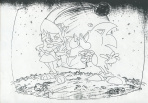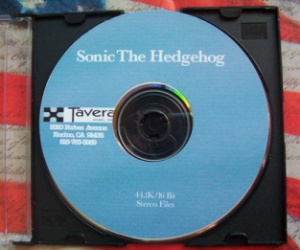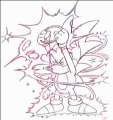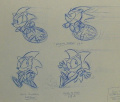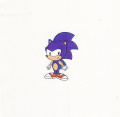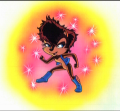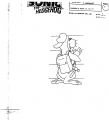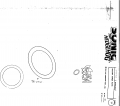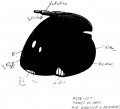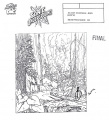Sonic the Hedgehog (TV series)/Development
From Sonic Retro
(Redirected from Early Sonic the Hedgehog cartoon)
- Back to: Sonic the Hedgehog (TV series).
Sonic the Hedgehog went through a number of concepts and changes through its development process. What follows is a collection and summary of what that entailed.
Contents
Development
Conception and season one

After recognizing the potential of Sonic the Hedgehog as a brand, Sega of America CEO Tom Kalinske knew he wanted to take the character and have a television show built around him. While working at Mattel in the 1980's, Kalinske had taken a similar approach with the "Masters of the Universe" toy line, and felt it would serve Sonic in a similar fashion. In 1991, Kalinske initially met with Haim Saban to talk over the idea of an animated Sonic series.[2]
Saban was not the only party interested in producing a Sonic the Hedgehog television series. Andy Heyward, the CEO of DIC Entertainment, reached out to Sega of America over the matter, expressing interest in the license.[3][4] The company was no stranger to adapting video game properties to television, having previously worked on various Super Mario Bros. series and Captain N: The Game Master. Soon, the studio pitched the premise to Sega, with Sonic being part of a "Freedom Team" fighting against the evil Dr. Robotnik. A deal between the two companies was made, giving DIC the rights to move ahead on development and production. At about the same time, Sega of America entered into a deal with Allen Bohbot at Bohbot Entertainment for a second Sonic television show.[3]
Needing to find a home for the series, DIC reached out to the American television network ABC, and were pleasantly surprised by the results of their meeting.
| “ | At the time, the most prized placement for an animated series was Saturday morning on one of the networks. You got the best license fees and you also got the best ratings in that arena. So that was always your first port of call when you had a hot property...you go to the network. We did that with Sonic, and they gave us an on the air commitment immediately. And that's unusual! Normally a network will make a development deal with you which basically gives them the right to buy the property at a later date and expect you to write a pilot script and do some development art and they put off their decision. But...if the property is really hot they'll give you an on-air commitment right on the spot and that's what happened with Sonic. | „ |
| — Robby London, Executive Producer of Sonic the Hedgehog[4] | ||
With the show greenlit, ABC requested that Len Janson and Chuck Menville be the story editors of the series. The duo were seasoned animation veterans, having worked on numerous projects together including The Real Ghostbusters where they served as both writers and story editors.[5] Unfortunately, Chuck Menville was unavailable, fighting the final stages of non-Hodgkin's lymphoma.[6] Instead, Len Janson was joined by father-son writing team[7] Bruce and Reed Shelly, who had previously written for both The Super Mario Bros. Super Show and The Adventures of Super Mario Bros. 3.
The three men co-wrote the series Bible, fleshing out the original premise and retooling the supporting cast. Characters that were originally based on the animal friends of the video games were replaced with characters such as Bunnie Rabbot, Antoine, and Rotor Walrus (originally named Boomer)[8] who, along with Sonic, Sally, and Miles "Tails" Prower would fight against the evil Dr. Robotnik and his assistant, Snively (originally named Quizley).[9] Reportedly, the concept of character bibles was foreign to Sega of America, with Michealene Cristini Risley's experience working with bibles at Disney and Marvel able to convince the team to create them.[3]
| “ | I think we needed to understand what the brand was. When we were building new characters, we did character bibles, so we knew what could and couldn't happen. Like my early training at Disney. And Disney's the pinnacle of branding. And so we always had to have, for each of the characters, “here's how Sonic would respond in this situation.” “Here's how Princess Sally would.” So it's knowing the characters, knowing the storylines, knowing what they can and cannot do. | „ |
Casting responsibilities for the series were assigned to Marsha Goodman and Virginia McSwain. Knowing that the show was to be pitched to ABC, they wanted to find someone to play Sonic who would appeal to the network executives.[10] The role was offered to Jaleel White, who had made a name for himself playing Steven Q. Urkel on the primetime sitcom Family Matters, at the time a hit on ABC's TGIF lineup. Previously, DIC had approached Jaleel while developing an Urkel-centric animated Family Matters spin off, and while it was not picked up, it did begin a working relationship with the actor and the animation studio.[4] Having always wanted to play a voice on an animated project, Jaleel accepted. Other well known names were soon attached to the project, including Kath Soucie, Jim Cummings, and Bradley Pierce, the latter of which had recently starred as Chip in Disney's Beauty and the Beast. While the majority of the cast would record episodes together, Jaleel would end up recording his parts separately, due to his hectic schedule.[10] Being a minor, the hours he could work in a given day were legally limited.
Having such faith in the show they were creating, DIC felt Sonic the Hedgehog could support being both a Saturday morning series and a weekly syndicated series. After getting the green light to make the series in the first place, DIC had a meeting with Mark Pedowitz, the Senior Vice President of Business Affairs and Contracts at ABC, to discuss the possibility of launching the series in both forms concurrently.[11] This was not the first time DIC had entered into such an arrangement with ABC, having produced two seasons of The Real Ghostbusters in 1987 - one for the network, another that aired in syndication at the same time.[12] However, ABC made it clear they wanted the series to be exclusive to them, and if DIC pursued making a concurrent version for syndication they would not air Sonic on Saturday mornings.[11] Not wanting to give up the idea, Robby London, who became the executive producer on Sonic the Hedgehog, pitched an idea to his boss, Andy Heyward. The idea was to develop two separate shows - one that would be a "serious and somewhat dark story" that ABC was looking for, and another show that would make "Robotnik more silly" and give him "henchmen that were incompetent," emulating the style of Tex Avery cartoons.[4] Approaching ABC with this new take, DIC emphasized the idea that the version of Sonic they would air would still be unique, that no one would confuse the two shows because of their vastly different tone, and that it would only help them by bring greater awareness of the Sonic the Hedgehog brand. To DIC's surprise, the network gave the production company the green light to develop both shows.[4]
Bruce and Reed Shelly would step away from Sonic the Hedgehog, creating the more comical Adventures of Sonic the Hedgehog.[13] Len Janson was left to become the showrunner for the network series. Embracing the idea of making a darker animated show, the characters and settings as seen in the pilot "Heads or Tails" were redesigned for the full series. This slightly more mature feel for the show was reflected in the writing, Len wanting there to be wins and losses for the characters,[14] made clear in such episodes as "Sonic Boom" and "Ultra Sonic." Even so, each episode was a standalone story, told by different writers who were not trying to present an overarching narrative.
As part of the agreement to make a show based on the Sonic the Hedgehog property, Sega maintained approval rights on all aspects of the series - voices, music, scripts, and character designs.[15] DIC's first assigned supervisor from Sega immediately caused conflict in the creative process, knowing nothing about animation production and often giving unclear or contradictory instructions.[16] This individual was initially replaced by Entertainment & Consumer Products licensing executive Cynthia Modders ("the day-to-day on Sonic"),[3] who worked with DIC until Jane Thompson, Sega of America's Director of Licensing and Character Development, stepped in. Often working with DIC in their Burbank office, the relationship between her and DIC proved fruitful, with Robby London feeling she helped the team create better material through the course of their partnership.[4]
Season two

With the show picked up for a second season, Len wanted to reassess the series, seeing which aspects worked and which ones didn't. Trusting their views on the characters, Len brought in the writing team of Ben Hurst and Pat Allee, who had written the episode "Sonic and Sally." Together, the three of them rewatched the entirety of the first season, examining the highs and lows while also brainstorming what could come next. Early on in the two week process of outlining the second season, the idea of treating the thirteen episodes as one long film narrative came up. The only rule would be that, with the exception of the "Blast to the Past" two parter, each episode had to stand on its own merits, as they still had to be friendly to any potential new viewers week to week.
The creative team was also forced to accommodate two requests from ABC. The first of these was adding a new character that would appeal to the female demographic, resulting in the creation of Dulcy the Dragon. The second was the insistence of having four, 11-minute episodes focusing on Antoine, played up for comedy. This second request was not met with favor from Ben Hurst, the loss of two full episodes truncating the original intent of the season.
As pre-production on the second season continued, the designs of the characters were also tweaked. Some were subtle, such as the addition of Sally's vest, while others were vastly different, Janson insisting Rotor be completely redesigned.[18]
With a quarter of a million dollars budgeted for each episode, regular production began, the team having a week to turn around each script. The three worked in tandem, with the main swathes of the plot coming from Ben Hurst, character development primarily worked on by Len Janson and Pat Allee, and rough dialogue coming from Hurst that would be polished by Allee and finally Janson. Once the script was complete, it would head off to be storyboarded, with further tweaks done by Len and director Ron Myrick once the boarding was complete.[14][18]
While those who worked on the series were excited over what they were creating, there was more than one occasion in which Len was forced to bump heads with not just the executives at ABC, but also those at Sega. One such disagreement occurred during the development of the second season when Ben Hurst set out to define the backstory of Robotnik and Snively.
| “ | Julian and Snively were part of a space expedition from about 2200 (or thereabouts). Julian attempted a takeover of the colony, but his technology got out of control and he wound up destroying everything, narrowly escaping with his (and Snively's) lives. Meanwhile, back on Earth, a nuclear holocaust had destroyed human life as we knew it - and the animals who survived mutated into sentient beings and built the society which you see in the form of Mobius. Einstein's ideas of the passage of time during faster-than-light space travel kick in and thousands of years have passed by the time Julian and Snively returned to find this "Animal" world. Well, Julian's thought was that in the land of the four-pawed critters, the two-handed man is king and so he set about to take over - as outlined in Blast to the Past. | „ |
| — Ben Hurst, writer and associate story editor of Sonic the Hedgehog[19] | ||
Though the outlined events listed on this "whitepaper" were not intended to be seen on screen during season two, Sega was upset over this drastic turn from the source material they presented. Len stayed firm, defending the continuity the team had come up with, feeling that it was better than the materials Sega had presented them with when the series was initially conceived.[14]
Cancellation and attempted relaunches
The final episode to air, "The Doomsday Project," ended on a cliffhanger, the team fully expecting to be picked up for a third season. The earliest sketches of a season outline had already been written when word came of the series' cancellation.[20] A number of explanations have been given as to why the show ended prematurely, including disinterest in the show from the new head of ABC's Children's Programming, plus the fact it was often preempted by college football on the west coast.[21] The most prominent reason for the show ending was ratings. In the fall of 1994, Sonic aired at the same time as the Fox Kids program Mighty Morphin Power Rangers,[22] which was quickly becoming one of the most popular children's entertainment properties.[23] These three elements, when combined, proved to be the demise of the series.[21]
In 1997, DIC began development on a third show featuring Sonic the Hedgehog, Sonic Underground, this time without Len Janson's involvement. Ben Hurst and Pat Allee were among those invited to an open call for writers to pitch for the new series. Though Ben Hurst was hesitant to go, the meeting led to him becoming the showrunner. While he was able to integrate certain aspects of the "SatAM" aesthetic, the format of Underground had already been set in stone, the writer unable to shift course and create the third season of former Saturday morning series.[24]
Communicating with fans online, and recognizing the desire for a third season of Sonic the Hedgehog, Hurst began conceiving ways to resurrect the series as early as September of 1998, while still working on Underground.[25] However, he recognized that such a task was nothing short of an uphill battle. During the San Diego Comic Con in August of 1999, Hurst met up with Ken Penders, one of the main writers on the Sonic the Hedgehog comic book from Archie Comics. After that initial meeting, the two spoke on the phone, discussing the possibility of Ben Hurst writing for the comic.[26]
| “ | Ben expressed interest in writing for the Sonic comic...As Archie was publishing the SONIC SUPER SPECIAL series at the time, I thought it would be a great idea for Ben to write where he would have taken the series. He suggested that if he did do the story, he'd want to take what he planned and fit it into the series' continuity. So I contacted Justin Gabrie, and told him about Ben's interest. When Ben found out what Archie paid per page for script was nowhere near what he was paid for the scripts he did for the Sonic animated series he worked on, he decided to pass. (Which was sad, because Art Mawhinney would have been assigned to illustrate that particular script.) | „ |
| — Ken Penders, writer of Archie's Sonic the Hedgehog[26] | ||
With Archie off the table, Ben Hurst turned back to the idea of continuing the series through animation. Though his desire was to write a full thirteen episode season, he also considered the possibility of writing a movie that would wrap things up, either theatrically released or direct to video. On February 29th, 2000,[27] Ben had a meeting with Robby London, an executive producer on all three DiC-created Sonic programs. During this meeting, the pair discussed the many aspects of what it would take for such a project to be greenlit, including the enthusiasm of the fanbase. After the meeting, Ben made an open call on the Usenet group alt.fan.sonic-hedgehog, asking the fans to start mailing in letters to local television network affiliates asking them to air Sonic the Hedgehog. The hope was that, if local stations saw a demand, the prospect of more Sonic in syndication would become a more enticing proposition.[28]
At the end of Hurst's meeting with London, the producer gave the writer the contact information of an executive within Sega of America. Not long after, Hurst telephoned the executive, speaking to her about his ideas for continuing the Saturday morning Sonic series as an animated film.[24] The following day, he received an unprompted call from Ken Penders.
| “ | The next day, I got a call from Ken Penders, who had been alerted by his contact in their office that I was interested in getting a Sonic movie going. I generously offered to include him in the effort and told him my strategy. Get SEGA to become invested in the idea by hiring us to interview their creative game designers, execs, etc and see if we could develop a story line that would fulfill the third season - and simultaneously give them creative ideas to develop new games. A win-win, situation. | „ |
| — Ben Hurst, writer and associate story editor of Sonic the Hedgehog[24] | ||
Ken Penders made clear his insider knowledge during an online chat with fans on March 8th, 2000, saying a third season of Sonic the Hedgehog was in the early stages of development.[29] He also claimed that the episodes would include elements of the Archie comic books. The idea of melding both the Saturday morning series and the ongoing comic was doubled down in a later online chat that occurred June 1st that same year, this time saying that it would take the form of a movie, and that Hurst was already working on a first draft.[30]
On August 30th, 2000, Penders went on record that the film version of Sonic was in "development hell," not getting into any further detail.[31] Years later, Penders claimed Hurst was being unrealistic in the way he was going about the project, telling him that the "approach would be a non-starter, and I was never able to shake Ben's belief that Sega would be willing to pay us to do the project."[26] This fear was reportedly made clear in a later phone call Hurst had with the same Sega executive he initially contacted.
| “ | I called SEGA back, but I was shocked when the exec "lit" into me, telling me, "People pay US to develop Sonic product, we don't pay them!" Then she hung up on me. Obviously, Penders had related my strategy to them in a less-than-flattering way. | „ |
| — Ben Hurst, writer and associate story editor of Sonic the Hedgehog[24] | ||
After that call, Ben Hurst pulled back from actively pursuing a continuation of the cartoon series. In 2003, though he was not involved in any active development with Sega or DIC, Hurst began personally fleshing out an outline for what would be an animated film finale for the series. In 2005, he attempted once more to gain interest in bringing back the series.[14] What that entailed is unknown, and when asked the following year, he refused to comment.[18]
Original pitch concept art
In Sonic the Comic issue 12, the "News Zone" column featured a short write-up on the upcoming television series Adventures of Sonic the Hedgehog. While the article did have an image of Dr. Robotnik as he would look in that series, two out of place images were lined up alongside. These images would later be reprinted, along with three others, in the first issue of Fleetway's Sonic the Poster Mag, with the only context being that it was a "sneak peak" of "TV's newest superstar."
As the images did not reflect either Sonic animated series in their final form, it was quickly surmised that these images were in fact early conceptual drawings as to what a Sonic series could entail. While the artist is currently unknown, the attached story pitch was most likely written by Phil Harnage, a staff writer at DIC.[32] The material was based on the original Sonic the Hedgehog Bible from Sega of America, supplied to the studio by Al Nilsen.[33]
The design of Sonic, Sally, and Robotnik in this concept art were also used on a promotional card from European distributor Silvio Berlusconi Communications.
"The Freedom Team," featuring redesigned versions of Johnny Lightfoot, Porker Lewis, Joe Sushi, Tux, Chirps, and Flicky. These characters would not end up being in the animated Sonic the Hedgehog.
Sonic the Hedgehog (revised Bible)
The original series Bible for Sonic the Hedgehog had been revised twice by March 11th, 1992.[34] While the basic premise of the show had already been figured out, many of the details would continue to change over the coming year. Written mostly from the perspective of Sonic, the Bible describes how the show was to focus on Sonic and his band of Freedom Fighters who came together in the wake of Dr. Robotnik's takeover of Mobotropolis. The doctor, who stormed the city with his "ROBO SWAT TEAM," sought to capture everyone and subjugate them to his "Veg-O" machine, transforming them into robot slaves.[35] Though Sonic and his friends, including Boomer the Sea Lion, were able to escape, Sonic's Uncle Chuck and dog Muttski unfortunately were captured.
In the wake of Robotnik taking over the entire planet, Sonic ended up meeting Princess Sally and a member of the royal guard, Antoine. Both human, they had escaped to the Great Forest but were tracked down by Robotnik's SWATbots. Before Robotnik's forces could capture the princess, Sonic rushed into save the pair, the young princess thankful for the rescue. While Antoine immediately took a dislike to the hedgehog, they both joined up with Sonic and the Freedom Fighters, taking refuge in the hidden village of Knothole.
This early series Bible also includes Miles "Tails" Prower as a principle character, a four and a half year old fox who adores Sonic, wears a cowboy hat, and speaks with a southern accent.[36] Living all his life in the Great Forest, he was told by the Freedom Fighters not to venture out and explore the city, even though all he wants is to join them on adventures.[37] Rounding out the cast is Nate Morgan, the former "environmental adviser" to the king.[38] A grandfather figure to Tails, he is described as being a former wizard whose powers did not necessarily come in handy when needed the most.
By the time the script for the series' pilot, "Heads or Tails," was completed, numerous details of Sonic's world had been changed, including Princess Sally and Antoine's species, the accent of Tails, and the removal of Nate Morgan.[39]
Original opening
When putting together the pilot episode "Heads or Tails," an intro using the designs from the pilot was also animated. By the time the episode finally aired on ABC, this original intro had been removed, replaced by the more familiar opening that would be seen in the rest of the series. While never released to the public, this original intro was completed, and featured at the Sega booth at Summer CES 1993.[40] The storyboards for the original opening were included in the Sonic the Hedgehog The Complete Series DVD boxset by Shout Factory.[41]
Sonic rushing past his logo.[42]
Engaging with the logo.[43]
Line art.[43]
Full animation cell.[44]
Painted Robotnik.[44]
Line art.[44]
Full animation cell and corresponding line art.[45]
Sonic taunting SWATbots.[46]
Background only.[46]
Holding a power ring.[47]
Line art.[47]
Sonic rescuing his friends.[48]
Line art.[48]
Sonic and his logo.[43]
Painted Sonic.[43]
Line art.[43]
Music
Before the series went to air, a number of potential theme songs for Sonic the Hedgehog were composed, each of them rejected by ABC. Sensing he knew what the network was looking for, Robby London wrote a demo and submitted it for approval.[4] The network accepted it, and after further tweaking, it became the main theme of the show. During the first few episodes of the first season, the song was performed by Doni Flanigan.[49] Reruns of these episodes would replace Doni's version with the song performed by Noisy Neighbors, which would be the version featured on season two and all home video releases.
The orchestral music of the show was composed by Michael Tavera, who was also responsible for a handful of the unused theme songs meant for Sonic. These demo themes were released on the Internet in 2006, when "Fans United for SatAM" user Cheezmatt got in contact with Tavera, asking if he still had any of the backing tracks for Sonic the Hedgehog in his personal archives, and if so, would be willing to share them. While most of the music that ended up in the show was located in DIC's archives and thus unavailable, Tavera sent a CD containing what he still personally had.[50]
| 1. Sonic the Hedgehog Orchestral "Main Title" in 48 kHz (1:13) |
|---|
| 2. Sonic the Hedgehog Orchestral "Main Title" in 44 kHz (1:15) |
|---|
| 3. Unused theme song 1 (1:03) |
|---|
| 4. Unused theme song 2 (1:04) |
|---|
| 5. Unused theme song 3 (1:03) |
|---|
| 6. Unused theme song 4 (1:04) |
|---|
| 7. Unused theme song 4 (alternate) (1:03) |
|---|
| 8. Unused music (1:04) |
|---|
| 9. Music used in Captain N: The Game Master (1:02) |
|---|
| 10. Unused music (1:04) |
|---|
| 11. Robotropolis music (1:00) |
|---|
| 12. Sonic the Hedgehog 2 intro and Emerald Hill Zone theme (0:55) |
|---|
| ► Running time: 12:50 |
|---|
Season 3
| |
Main article: Sonic the Hedgehog (TV series)/Development/Ben Hurst's Ideas |
After wrapping up season two, it wasn't long before Ben Hurst began outlining the third season of Sonic the Hedgehog. Before any scripts were written, word came that the series had been canceled. The first hint of what season three was originally meant to entail came in the form of an e-mail, when fan Alessandro Sanasi tracked down Ben's e-mail address and asked him about the cliffhanger.
| “ | The red eyes you saw were NAGUS, the sorcerer trapped in the Void...At the moment the Doomsday machine was destroyed, [Nagus] was able to exploit the energies and pull Robotnik into the Void. Snively takes over...Robotropolis...during the first two episodes, he battles the Freedom Fighters. Without Robotnik's cunning, however, he finds himself on the brink of losing everything. Meanwhile, Nagus is having a delightful time 'torturing' Robotnik while plotting his...escape. He's... discovered the magic which will enable him to leave the Void without turning to crystal...But...Robotnik has found a means to communicate with Snively--telling the little guy his location. Snively...tells Robotnik where he can get off.
But then, as the Freedom Fighters are on the brink of taking over Robotropolis, Snively opens the Void, releasing Robotnik-- and accidentally releasing Nagus and Sally's father.... Now Nagus is in charge, Robotnik is his "Snively", and Snively becomes a nobody. Nagus uses the King to bait a trap to catch Sally. Robotnik plots to regain his power and Snively defects to the Freedom Fighters. |
„ |
| — Ben Hurst, writer and associate story editor of Sonic the Hedgehog[51] | ||
After Ben Hurst's death in 2010, a series of e-mails written by him were released to the public. Composed during 2003 and 2004, they served as the beginnings of an outline for a potential Sonic the Hedgehog movie, following up on the cliffhanger of season two.[52] The film would have started with the Freedom Fighters, now called the Freedom Builders, working on restoring Robotropolis to its former glory. Unbeknownst to the group, their movements in the city would be watched by Snively, and as the film progressed, would prove to be a formidable opponent, in some ways better at strategy than Dr. Robotnik.
The role of NICOLE, Sally's handheld computer, would have been one of the focal points in the story. The plan was to reveal that, prior to the events of "Blast to the Past," Sally was friends with a young girl named Nicole. A child genius, she caught the attention of Dr. Robotnik, who lured her into his lab so he could transform her mind into a sophisticated artificial intelligence. Thinking he has her under his control, he is unaware of her complete sentience, which has also given her the ability to control minds. Running through a number of scenarios, she decides the only thing she can do is make Robotnik forget she exists, while also wiping her own memories as to prevent her from abusing her newfound powers. Her final act before removing her free will was to make sure she would end up in the hands of her friend, Princess Sally.
This backstory would have been revealed to Sonic during the film, as he and NICOLE spent more time one on one. Asking her a variety of questions to try and understand how she works, he realizes there is more to her than meets the eye when she stumbles across her words, going silent for a moment. Coming back online, Sonic asks what she was doing, but NICOLE is unable to recall, having already erased from her memory the fact she prevented Snively from turning on a second NICOLE unit that Robotnik had among his personal belongings.[53]
A handful of other threads were known to be part of Ben Hurst's conceptual season three. Among these details would have been the further exploration of Dulcy the Dragon's abilities and character growth for Miles "Tails" Prower.[54] The framework for a love triangle between Sonic, Sally, and a new character was also toyed with, though no details regarding the new character were ever made public. Hurst also hinted that "big plans" were in store for Antoine.[14] While he never went on record stating what those plans were, Sonique, former webmaster of "Fans United for SatAM," recalled in a conversation she had with Hurst that "when Snively turned to the Freedom Fighters, he'd eventually try to betray them, and Antoine would be the one to figure it out. But of course he wouldn't figure it out right away, he'd be sitting right on the piece of evidence that would reveal it, but of course it being Antoine would take him a while to catch on."[55]
One detail Ben Hurst never made public was how the story of Sonic and the Freedom Fighters were meant to end. In the remote chance that the series would continue in some form or fashion, he did not want to spoil the story for the fans.[14]
Concept art
Characters
Sonic the Hedgehog
Line art of Sonic running, with flame trail.[56]
Princess Sally Acorn
Wearing harem pants.[57]
Confidently posed.[58]
Reverse.[59]
Two expressions.[60]
Another sketch.[61]
Rotor Walrus
Bunnie Rabbot
Antoine Depardieu
Miles "Tails" Prower
Muttski
Dr. Ivo Robotnik
Snively, SWATbots, and Cluck
Other
Backgrounds and settings
A map of Mobius, showing the relative positions of Knothole and Robotropolis.[68]
Close-up.[68]
A detailed map of the Great Forest.[69]
Close-up.[69]
Great Forest meadow.[70]
Close-up.[70]
Edge of meadow in Knothole.[71]
Close-up.[71]
Edge of meadow.[72]
Great Forest trail.[73]
Close-up.[73]
Knothole spring.[74]
Close-up.[74]
Ext. Village/Great Desert w/Mobotropolis.[75]
Production art
Character model sheets and stock art
Sonic the Hedgehog
"Turns" model sheet. Created for the pilot.
Sonic's "G-Force" expression.[76]
Sonic in hooded cloak. From "Sonic Racer."
Sonic caught in a transparent ball. From "Game Guy."
Sonic trapped in mega-muck. From "Dulcy"
Sonic wearing a parka, color guide. From The Odd Couple.
Sonic's body turning into crystal. From "The Void."
Sonic in a chef's hat. From The Odd Couple.
Sonic wearing socks. From The Odd Couple.
Sonic with a smoldering butt. From "Cry of the Wolf."
Sonic with singed spikes. From "The Doomsday Project."
Sonic using the Deep Power Stones. From "The Doomsday Project."
Princess Sally Acorn
Stock art of Sally's pilot design.[77]
Sally's original color scheme. It was used in issue 0 of the Sonic the Hedgehog mini-series by Archie Comics.[77]
Color guide. [78]
In color. [79]
Line art of Sally, season two.[80]
Three-quarter view of Princess Sally for season two. [80]
Wearing a magnetic vest. From "Spyhog."
Rotor Walrus
"Turns" model sheet of Rotor. Created for the pilot.[81]
Stock art of Rotor in various poses.[82]
"Turn Around" sheet of Rotor, season one.[78]
Three-quarter view of Rotor with alternate color scheme.[78]
"Turn around" sheet of Rotor, season two.[78]
Bunnie Rabbot
Three-quarter view of Bunnie Rabbot with incorrect leg coloring.[78]
Non-roboticized form. From "Sonic Conversion."
Antoine Depardieu
Pilot design turn around color guide.[78]
Antoine disguised as a SWATbot. From "Sonic's Nightmare."
Antoine wearing a "royal robe" and "metal crown." From "Fed Up with Antoine."
Wearing a cast. From Ro-Becca.
Miles "Tails" Prower
"Turns" model sheet with corrected colors.[83]
Color Guide.[78]
Three-quarter view of Miles "Tails" Prower, with "day" color scheme.[84]
Uncle Chuck
Uncle Chuck turns, with color. For the pilot.[85]
Dulcy the Dragon
Three-quarter view of Dulcy, using an earlier color scheme.[78]
Fire breath.[86]
Ice breath.[87]
Smoke trail.[88]
Lupe & the Wolf Pack
Lupe, introduced in "Cry of the Wolf."
Dr. Ivo Robotnik
Snively, SWATbots, and other robots
Color guide.[78]
Stock art of side view.[91]
SWATbot turn around color guide.[78]
Construction of a buzzbomber.
Other
Object Model Sheets
Heads or Tails
Front of sleek hovercraft.[92]
Three-quarter front.[92]
Bottom view.[92]
Multiple views, with instructions on how it works.[92]
Cluck's eyeball.[92]
A red light.[92]
A panel of buttons on Robotnik's chair.[92]
A fish for Rotor to eat.[92]
Rotor wearing a backpack. The sheet still refers to him as Boomer.[92]
Rotor's backpack.[92]
Sonic's backpack.[92]
A floating spy camera.[92]
A haystack, which the Freedom Fighters land in.[92]
A broken catapult arm.[92]
A catapult.[92]
Three-quarter view.[92]
Diagram of catapault.[92]
A new throwing arm for the catapult.[92]
Holographic image of catapult.[92]
Rotor's "napkin."[92]
Three-quarter front view of patrol vehicle.[92]
Three-quarter back view.[92]
Rear.[92]
Instructional sheet describing how it works.[92]
Robotropolis dumpster.[92]
An exhaust pipe.[92]
A photo of Uncle Chuck and Muttski.[92]
Metal spitball bullets.[92]
Sonic's watch.[92]
Other
Robotnik's war room chair.[93]
A chair for a roboticizer. From "Sonic and Sally"
The Freedom Stormer. From "Sonic and the Secret Scrolls."[92]
Snively's control box. From "Sonic and the Secret Scrolls."[92]
A large computer terminal. From "Sonic Racer."[92]
An antenna relay. From "Sonic Racer."[92]
A hover racer. From "Sonic Racer."[92]
A curiously shaped remote control device. From "Hooked on Sonics."[92]
Robotnik's hovercraft. From "Hooked on Sonics."[92]
Sonic radar machine. From "Hooked on Sonics."[92]
Laser howitzer. From "Hooked on Sonics."[92]
Telescope. From "Harmonic Sonic."[92]
Backgrounds
"Heads or Tails"
An unused background of the "Veg-O-Matic" machine.
The roboticization facility from the pilot's original opening.[94]
Line art of Mobotropolis, likely from the original opening.[94]
In color.[94]
Robotropolis.[94]
The original Power Ring Grotto, line art.[82]
Painted background.[94]
Path in the Great Forest.[94]
A dwelling in Knothole.[95]
Season one
A photograph of the line art.[96]
Dr. Robotnik's war room.[93]
In color.[94]
An area downtown.[97]
A section of wall in Robotropolis.[98]
The great plain.[94]
A partial segment of line art for a waterfall backdrop.[94]
The waterfall background in color.[94]
Another waterfall.[94]
Underground airbase. From "Sonic Boom."[99]
An air duct within Robotropolis. From "Sonic Boom."
Robotropolis city center. From "Sonic Boom."[100]
A Knothole cottage with a waterwheel. From "Super Sonic."
An image of the Great Forest. From "Sonic Past Cool."
Season two
The Power Ring Grotto.[94]
Sally's hut, with holographic projector.[100]
Knothole meeting area.[101]
Base camp in the Great Swamp. From "Game Guy."[95]
High above the Great Unknown. From "Game Guy."[95]
Great Unknown badlands. From "Game Guy."[95]
Line art of swirling sands. From "Game Guy."[94]
Swirling sands as seen through binoculars. From "Game Guy." [92]
Fortress door line art. From "Game Guy."[94]
Fortress Door. [95]
Initial interior of the fortress.[95]
The "game room" from eye level. From "Game Guy."[95]
Partial line art of the game room from above.[94]
In color, showing off the pinball field.[95]
Large hanger. From "Game Guy."[95]
Large crawl space. From "Game Guy."[95]
Partial line art of an abandoned gothic building. From "No Brainer."[94]
Full image in color.[95]
Junk pile on outskirts of Robotropolis. From "No Brainer."[94]
A higher resolution version, with watermark.[92]
Underground tunnel. From "No Brainer."[94]
Overhead view of Knothole. From "No Brainer."[95]
Partial lineart of Robotropolis street with Robotnik statue. From "No Brainer."[94]
Full sized version in color.[95]
Tree stump interior in Knothole. From "No Brainer."[95]
The floating island, housing the time stones. From "Blast to the Past."[94]
M.C. Escher-inspired corridor. From "Blast to the Past."[94]
The city of Mobotropolis. From "Blast to the Past."[94]
Mobotropolis palace grounds. From "Blast to the Past."[95]
The war ministry. From "Blast to the Past."[95]
Rooftop. From "Blast to the Past."[95]
Ruined chili dog stand. From "Blast to the Past."[95]
The first roboticizer. From "Blast to the Past."[95]
In color.[94]
Line art of Robotnik's bedroom. From "Dulcy."[94]
Full color version.[94]
Shine in the desert, line art. From "Dulcy."[94]
Full color version.[94]
Dragon's Nest partial line art. From "Dulcy."[94]
Full color version.[94]
A nest in Dragon's Nest. From "Dulcy."[94]
Color version.[94]
The Void.[95]
More of the Void.[95]
Land mass in the Void.[94]
Color version.[95]
The Void.[95]
A swirl to the Void.[95]
The Void.[95]
One more of the Void.[95]
Antoine's kitchen. From "The Odd Couple."[95]
Knothole hut in winter. From "The Odd Couple."[94]
Rotor's lab. From "Ro-Becca."[94]
More of Rotor's lab.[94]
Yet more of Rotor's lab.[94]
In color.[94]
Rotor's lab.[94]
A bridge in Knothole. Form "Ro-Becca."[94]
Great Canyon. From "Cry of the Wolf."[94]
Home of the Wolf Pack. From "Cry of the Wolf."[94]
Entrance area, with stairs, of the Wolf Pack's home. Sketch.[94]
Cleaned up line art.[94]
More of the Wolf Pack's home. Sketch.[94]
Cleaned up line art.[94]
Meeting area. From "Cry of the Wolf."[94]
Refinery in Robotropolis. From "Spyhog."[95]
Uncle Chuck's hideout, interior. From "Spyhog."[94]
Snively's interrogation room. From "Spyhog."[94]
The command center of the Doomsday Project. From "Spyhog."[102]
In color.[95]
The rear of Robotnik's HQ. From "Spyhog."[99]
The first level of the Doomsday Project machine. From "The Doomsday Project."[95]
Fueling room. From "The Doomsday Project."[95]
The roboticizer within the doomsday machine. From "The Doomsday Project."[94]
The main control room. From "The Doomsday Project."[94]
Sonic Underground repurposed model sheets
During the development of Sonic Undergrounds, a number of backgrounds developed for Sonic the Hedgehog were considered being reused for the show. While some did end up being repurposed such as Robotropolis, others such as the Knothole setting were not.
Opening
Other
References
- ↑ https://www.youtube.com/watch?v=xhBPuiPY8uY (Wayback Machine: 2023-04-29 17:55)
- ↑ https://medium.com/@romanojay/interview-with-tom-kalinske-former-ceo-of-sega-of-america-781d3d680b6f (Wayback Machine: 2019-12-18 13:25)
- ↑ 3.0 3.1 3.2 3.3 3.4 Interview: Michealene Cristini Risley (2025-01-21) by Alexander Rojas
- ↑ 4.0 4.1 4.2 4.3 4.4 4.5 4.6 https://www.youtube.com/watch?v=LLTX7TmU8Xo (Ghostarchive)
- ↑ https://www.youtube.com/watch?v=EC95zQ6OgFk (Ghostarchive)
- ↑ https://www.atogt.com/askoscar/display-person.php?id=40037 (Wayback Machine: 2023-06-05 03:32)
- ↑ https://www.inverse.com/gaming/sonic-hedgehog-chili-dog (Wayback Machine: 2023-02-07 07:22)
- ↑ File:SonicTH-SatAM Revised Bible 1992-03-11.pdf, page 13
- ↑ File:SonicTH-SatAM Revised Bible 1992-03-11.pdf, page 19
- ↑ 10.0 10.1 https://www.youtube.com/watch?v=9XwWHTigA9s (Ghostarchive)
- ↑ 11.0 11.1 https://www.polygon.com/2020/2/18/21140375/sonic-90s-cartoons-streaming-satam-jaleel-white-adventures-of-sonic (Wayback Machine: 2022-11-03 18:00)
- ↑ @katewillaert on Twitter (Wayback Machine: 2022-07-08 04:49)
- ↑ https://www.inverse.com/gaming/sonic-hedgehog-chili-dog (Wayback Machine: 2022-04-07 14:26)
- ↑ 14.0 14.1 14.2 14.3 14.4 14.5 Ben Hurst interview at SAGExpo (July 3, 2005)
- ↑ [Retro Gamer, issue 091, page 31 Retro Gamer, issue 091, page 31]
- ↑ https://www.youtube.com/watch?v=JwKhrGdvn_c (Ghostarchive)
- ↑ https://www.youtube.com/watch?v=GVpDEzQgs3M (Ghostarchive)
- ↑ 18.0 18.1 18.2 Ben Hurst interview at SAGExpo (August 27, 2006)
- ↑ https://groups.google.com/g/alt.fan.sonic-hedgehog/c/R4OkKOQeON4/m/rYBNdnqb3_4J (Wayback Machine: 2023-01-01 07:50)
- ↑ https://groups.google.com/g/alt.fan.sonic-hedgehog/c/LJD-zvxnb48/m/NaDH38_BCEQJ (Wayback Machine: 2023-01-03 05:19)
- ↑ 21.0 21.1 https://www.youtube.com/watch?v=tt5ERItK3CM (Ghostarchive)
- ↑ http://www.inthe90s.com/saturdays.shtml (Wayback Machine: 2022-12-16 22:06)
- ↑ https://www.nytimes.com/1994/12/05/us/with-power-rangers-scarce-a-frenzied-search-by-parents.html (Wayback Machine: 2022-11-26 21:00)
- ↑ 24.0 24.1 24.2 24.3 https://groups.google.com/g/alt.fan.sonic-hedgehog/c/_QnS6Xqsr70/m/bBucDGsDsKoJ (Wayback Machine: 2023-01-03 05:34)
- ↑ https://groups.google.com/g/alt.fan.sonic-hedgehog/c/EEf5Pyt8IXc/m/RZalFsPxUvoJ (Wayback Machine: 2023-01-01 08:47)
- ↑ 26.0 26.1 26.2 https://forums.sonicretro.org/index.php?threads/the-ken-penders-chronicles-a-man-you-ken-dependers-on.21670/page-22 (Wayback Machine: 2023-01-03 05:41)
- ↑ http://www.teamartail.com/satam/ (Wayback Machine: 2000-08-22 01:58)
- ↑ https://groups.google.com/g/alt.fan.sonic-hedgehog/c/KVHYABMAk88/m/dlC8mwr4YucJ (Wayback Machine: 2023-01-01 10:18)
- ↑ http://freepages.rootsweb.com:80/~bauerle/chat2.lis (Wayback Machine: 2003-10-06 22:46)
- ↑ http://freepages.rootsweb.com:80/~bauerle/chat2.txt (Wayback Machine: 2003-10-06 22:51)
- ↑ http://freepages.rootsweb.com:80/~bauerle/chat3.txt (Wayback Machine: 2003-12-04 21:46)
- ↑ @SatamHistorian on Twitter (Wayback Machine: 2022-03-26 02:05)
- ↑ @SatamHistorian on Twitter (Wayback Machine: 2022-03-26 02:06)
- ↑ File:SonicTH-SatAM Revised Bible 1992-03-11.pdf, page 1
- ↑ File:SonicTH-SatAM Revised Bible 1992-03-11.pdf, page 3
- ↑ File:SonicTH-SatAM Revised Bible 1992-03-11.pdf, page 9
- ↑ File:SonicTH-SatAM Revised Bible 1992-03-11.pdf, page 10
- ↑ File:SonicTH-SatAM Revised Bible 1992-03-11.pdf, page 15
- ↑ File:SonicTH-SatAM Heads or Tails Script 1992-08-06.pdf
- ↑ https://youtube.com/watch?v=sIsYIp3wknY?t=180 (Ghostarchive)
- ↑ https://www.youtube.com/watch?v=4W-wKw6sPlA (Ghostarchive)
- ↑ https://comics.ha.com/itm/animation-art/production-cel/sonic-the-hedgehog-title-card-production-cel-setup-dic-c-1993-94-/a/122115-14010.s (Wayback Machine: 2022-12-19 08:17)
- ↑ 43.0 43.1 43.2 43.3 43.4 https://comics.ha.com/itm/animation-art/sonic-the-hedgehog-title-card-production-cel-setup-and-animation-drawing-group-of-6-dic-c-1993-94-total-3-/a/7254-17212.s?ic4=GalleryView-Thumbnail-071515 (Wayback Machine: 2022-12-13 06:08)
- ↑ 44.0 44.1 44.2 @max6464646464 on Twitter (Wayback Machine: 2020-11-27 19:32)
- ↑ https://comics.ha.com/itm/animation-art/sonic-the-hedgehog-doctor-robotnik-production-cel-and-animation-drawing-dic-1999-total-2-original-art-/a/322210-47329.s?ic4=GalleryView-Thumbnail-071515 (Wayback Machine: 2022-12-13 06:54)
- ↑ 46.0 46.1 https://comics.ha.com/itm/animation-art/sonic-the-hedgehog-sonic-and-robots-production-cel-setup-with-production-background-dic-c-1993-94-/a/322217-49324.s?ic4=GalleryView-Thumbnail-071515 (Wayback Machine: 2022-12-13 06:19)
- ↑ 47.0 47.1 http://ledastudios.rubberslug.com/gallery/inv_info.asp?ItemID=196822 (Wayback Machine: 2016-02-08 16:14)
- ↑ 48.0 48.1 http://ledastudios.rubberslug.com/gallery/inv_info.asp?ItemID=171158 (Wayback Machine: 2021-03-01 12:37)
- ↑ @SatamHistorian on Twitter (Wayback Machine: 2022-01-10 04:31)
- ↑ http://www.saturdaymorningsonic.com/media/soundtrack (Wayback Machine: 2011-02-05 23:51)
- ↑ https://www.andrews.edu/~drazen/sonfaqs.htm (Wayback Machine: 2022-10-04 23:07)
- ↑ http://www.saturdaymorningsonic.com/features/bens_notes (Wayback Machine: 2011-02-06 02:15)
- ↑ Sonic the Hedgehog (TV series)/Development/Ben Hurst's Ideas
- ↑ https://www.sonicsatam.com/information/ben-hurst-memorial-and-tribute/ (Wayback Machine: 2022-08-22 15:12)
- ↑ http://www.saturdaymorningsonic.com/features/bens_notes/ (Wayback Machine: 2022-03-16 21:57)
- ↑ http://ledastudios.rubberslug.com/gallery/inv_info.asp?ItemID=383968 (Wayback Machine: 2021-02-25 10:32)
- ↑ http://ledastudios.rubberslug.com/gallery/inv_info.asp?ItemID=383963 (Wayback Machine: 2022-12-24 11:14)
- ↑ http://ledastudios.rubberslug.com/gallery/inv_info.asp?ItemID=392817 (Wayback Machine: 2021-02-25 10:25)
- ↑ http://ledastudios.rubberslug.com/gallery/inv_info.asp?ItemID=392816 (Wayback Machine: 2021-02-25 11:03)
- ↑ http://ledastudios.rubberslug.com/gallery/inv_info.asp?ItemID=392815 (Wayback Machine: 2021-02-25 10:03)
- ↑ http://ledastudios.rubberslug.com/gallery/inv_info.asp?ItemID=383965 (Wayback Machine: 2021-02-25 10:52)
- ↑ http://ledastudios.rubberslug.com/gallery/inv_info.asp?ItemID=383960 (Wayback Machine: 2022-12-22 10:52)
- ↑ http://ledastudios.rubberslug.com/gallery/inv_info.asp?ItemID=383961 (Wayback Machine: 2022-12-22 10:52)
- ↑ http://ledastudios.rubberslug.com/gallery/inv_info.asp?ItemID=384088 (Wayback Machine: 2021-02-28 16:14)
- ↑ @Analytic_Art on Twitter (Wayback Machine: 2022-12-13 04:24)
- ↑ http://ledastudios.rubberslug.com/gallery/inv_info.asp?ItemID=383958 (Wayback Machine: 2015-10-13 14:53)
- ↑ http://ledastudios.rubberslug.com/gallery/inv_info.asp?ItemID=383949 (Wayback Machine: 2022-12-24 04:17)
- ↑ 68.0 68.1 https://www.worthpoint.com/worthopedia/sonic-hedgehog-production-hand-drawn-2007178933 (Wayback Machine: 2022-12-21 04:28)
- ↑ 69.0 69.1 https://www.worthpoint.com/worthopedia/sonic-hedgehog-production-hand-drawn-2006537710 (Wayback Machine: 2022-12-21 04:14)
- ↑ 70.0 70.1 https://www.worthpoint.com/worthopedia/sonic-hedgehog-production-hand-drawn-2006536464 (Wayback Machine: 2022-12-21 02:58)
- ↑ 71.0 71.1 https://www.worthpoint.com/worthopedia/sonic-hedgehog-production-hand-drawn-2006536477 (Wayback Machine: 2022-12-20 09:48)
- ↑ https://www.worthpoint.com/worthopedia/sonic-hedgehog-production-hand-drawn-2007178930 (Wayback Machine: 2022-12-21 01:51)
- ↑ 73.0 73.1 https://www.worthpoint.com/worthopedia/sonic-hedgehog-production-hand-drawn-2006536451 (Wayback Machine: 2022-12-21 01:59)
- ↑ 74.0 74.1 https://www.worthpoint.com/worthopedia/sonic-hedgehog-production-hand-drawn-2006537773 (Wayback Machine: 2022-12-21 02:47)
- ↑ https://www.worthpoint.com/worthopedia/sonic-hedgehog-production-hand-drawn-2005168439 (Wayback Machine: 2022-12-24 04:11)
- ↑ 76.0 76.1 https://www.facebook.com/PopKingInc/posts/sonic-the-hedgehog-concept-art-is-for-sale-now-on-ebay-through-our-daughter-comp/509493309183842/ (Wayback Machine: 2022-12-11 09:58)
- ↑ 77.0 77.1 http://ledastudios.rubberslug.com/gallery/inv_info.asp?ItemID=383964 (Wayback Machine: 2021-02-25 11:39)
- ↑ 78.00 78.01 78.02 78.03 78.04 78.05 78.06 78.07 78.08 78.09 78.10 http://www.saturdaymorningsonic.com/gallery/production-art/model-sheets/ (Wayback Machine: 2019-12-24 05:06)
- ↑ http://ledastudios.rubberslug.com/gallery/inv_info.asp?ItemID=429015 (Wayback Machine: 2021-03-01 12:49)
- ↑ 80.0 80.1 http://ledastudios.rubberslug.com/gallery/inv_info.asp?ItemID=429014 (Wayback Machine: 2021-02-25 11:12)
- ↑ http://ledastudios.rubberslug.com/gallery/inv_info.asp?ItemID=383947 (Wayback Machine: 2022-12-29 07:50)
- ↑ 82.0 82.1 Sonic Legacy Series Book 1
- ↑ http://ledastudios.rubberslug.com/gallery/inv_info.asp?ItemID=383948 (Wayback Machine: 2022-12-24 04:17)
- ↑ http://ledastudios.rubberslug.com/gallery/inv_info.asp?ItemID=429013 (Wayback Machine: 2021-03-01 12:26)
- ↑ http://ledastudios.rubberslug.com/gallery/inv_info.asp?ItemID=383946 (Wayback Machine: 2021-11-25 11:45)
- ↑ http://ledastudios.rubberslug.com/gallery/inv_info.asp?ItemID=383951 (Wayback Machine: 2022-12-24 07:39)
- ↑ http://ledastudios.rubberslug.com/gallery/inv_info.asp?ItemID=383952 (Wayback Machine: 2022-12-24 07:43)
- ↑ http://ledastudios.rubberslug.com/gallery/inv_info.asp?ItemID=383950 (Wayback Machine: 2021-02-25 11:02)
- ↑ http://ledastudios.rubberslug.com/gallery/inv_info.asp?ItemID=384086 (Wayback Machine: 2021-02-25 10:39)
- ↑ http://ledastudios.rubberslug.com/gallery/inv_info.asp?ItemID=383945 (Wayback Machine: 2021-11-16 09:48)
- ↑ http://ledastudios.rubberslug.com/gallery/inv_info.asp?ItemID=384090 (Wayback Machine: 2021-02-25 11:03)
- ↑ 92.00 92.01 92.02 92.03 92.04 92.05 92.06 92.07 92.08 92.09 92.10 92.11 92.12 92.13 92.14 92.15 92.16 92.17 92.18 92.19 92.20 92.21 92.22 92.23 92.24 92.25 92.26 92.27 92.28 92.29 92.30 92.31 92.32 92.33 92.34 92.35 92.36 92.37 92.38 92.39 92.40 92.41 https://www.sonicsatam.com/information/behind-the-scenes/ (Wayback Machine: 2022-08-22 15:12)
- ↑ 93.0 93.1 @KenPenders on Twitter (Wayback Machine: 2020-04-12 22:22)
- ↑ 94.00 94.01 94.02 94.03 94.04 94.05 94.06 94.07 94.08 94.09 94.10 94.11 94.12 94.13 94.14 94.15 94.16 94.17 94.18 94.19 94.20 94.21 94.22 94.23 94.24 94.25 94.26 94.27 94.28 94.29 94.30 94.31 94.32 94.33 94.34 94.35 94.36 94.37 94.38 94.39 94.40 94.41 94.42 94.43 94.44 94.45 94.46 94.47 94.48 94.49 [[Sonic the Hedgehog The Complete Series Bonus Feature]]
- ↑ 95.00 95.01 95.02 95.03 95.04 95.05 95.06 95.07 95.08 95.09 95.10 95.11 95.12 95.13 95.14 95.15 95.16 95.17 95.18 95.19 95.20 95.21 95.22 95.23 95.24 95.25 95.26 95.27 95.28 95.29 95.30 http://saturdaymorningsonic.com/gallery/production-art/concept-art--backgrounds/ (Wayback Machine: 2019-12-21 13:13)
- ↑ http://ledastudios.rubberslug.com/gallery/inv_info.asp?ItemID=383844 (Wayback Machine: 2021-03-01 13:48)
- ↑ http://ledastudios.rubberslug.com/gallery/inv_info.asp?ItemID=383845 (Wayback Machine: 2021-03-01 12:59)
- ↑ http://ledastudios.rubberslug.com/gallery/inv_info.asp?ItemID=383944 (Wayback Machine: 2022-12-28 08:59)
- ↑ 99.0 99.1 @KenPenders on Twitter (Wayback Machine: 2021-08-19 01:26)
- ↑ 100.0 100.1 @KenPenders on Twitter (Wayback Machine: 2020-04-12 22:18)
- ↑ @KenPenders on Twitter (Wayback Machine: 2020-04-12 22:19)
- ↑ @KenPenders on Twitter (Wayback Machine: 2020-04-14 07:08)
- ↑ http://ledastudios.rubberslug.com/gallery/inv_info.asp?ItemID=171154 (Wayback Machine: 2022-12-24 07:43)
- ↑ 104.0 104.1 @KenPenders on Twitter (Wayback Machine: 2022-05-21 16:39)
| Sonic the Hedgehog (TV series) | |
|---|---|
|
|
show;hide
|







